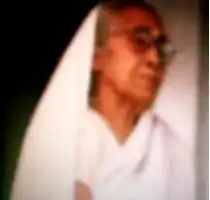Suhasini Das
Suhasini Das, Bengali: সুহাসিনী দাস (1915 - 30 May 2009) was an anti-British activist, social worker and politician from Bangladesh. She was a member of the Indian National Congress and an important figure in East Bengal, before, during and after Partition.
Suhasini Das | |
|---|---|
সুহাসিনী দাস | |
 | |
| Born | 1915 Jagannathpur |
| Died | 30 May 2009 |
| Citizenship | Bangladesh |
| Occupation | Social worker; Activist |
| Political party | Indian National Congress |
Biography
Das was born in 1915 in Jagannathpur village in Sunamganj district, East Bengal.[1] Her parents were Parimohan and Shobha Roy; she had two younger brothers and two younger sisters.[2] When she was six years old a school was built in her village - until then children had to travel 22 miles to Sylhet to be educated.[3] She was married aged 18 to a businessman, Kumud Chandra Das, who owned the Kuti-Chand Press.[3][2] Marriage had halted Das' education, however over the following years her friend Sarju, who was a private tutor, taught her how to read and write Bengali and English.[3] In 1938, she and her husband visited Kolkata and witnessed the funeral procession of Jatindra Mohan Sengutpta.[3] In 1939, her daughter Nilema was born, but shortly afterwards, her husband died of a fever.[3]
Career
The death of her husband enabled greater independence for Das - after a period of mourning, she decided to turn her house into a centre for thread-making and charkha, which enabled Bengali and Manipuri women and girls to earn money, but more importantly the work and the environment provided education.[3] In order to fund this she used the wealth inherited after the death of her husband.[2] The charkha became a symbol of Indian independence and on 20 January 1940, Das announced that she would only wear khaddar clothes for the rest of her life.[4]
Das was a supporter of Gandhi.[5] In 1942 she joined the Quit India Movement, which was under Gandhi's leadership; Das was imprisoned alongside other members.[6] She was also a supporter of the Non-Cooperation Movement.[7] She later joined the Indian National Congress.[4]
During Partition in 1947, Das travelled widely in the Sylhet area, encouraging Hindu people to stay at home and tried to calm their fears.[8] From 1946-7, Das worked in a relief camp in Noakhali, one of seventeen set up by Leela Roy, following the riots which took place there.[9] Whilst working there she contracted smallpox, and was visited by Gandhi whilst recovering.[6]
After Partition ended, Das remained in Sylhet and, along with Prunendu Sen and Nikunja Goswami, founded schools and set up a variety of strategies to enable communities to be financially stable.[3] In 1947, Das was instrumental in establishing the Rangirkul Ashram, which she ultimately became leader of.[2]
During the war for independence in 1971, it was Das' leadership which protected the ashram.[2] After independence, Das left politics to concentrate on her social and religious work.[4][8] However in 1973, she still attended a conference of anti-British freedom fighters in Delhi, where she highlighted to role of people from East Bengal in the struggle.[4]
In 1986, Das attended the World Hindu Congress in Nepal.[4] Religious tolerance and understanding was very important to her and in 1990 worked to restore faith between Hindus and Muslims after attacks on mosques and temples.[4]
Awards
In 1997, Bangladesh gave Das its highest award for 'Social Service'.[2]
Legacy
Das published her memoirs under the title Sekaler Sylhet ((Sylhet during the British Raj: Memories of Suhasini Das) in 2005.[5] These are a vital resource for understanding Partition in East Bengal, particularly from a female perspective.[11] These diaries recorded the rising dominance of the Muslim League and the pressures the Hindu minority felt.[12][13] One of the halls at Sylhet Agricultural University is named after her.[14]
References
- The trauma and the triumph : gender and partition in eastern India. Bagchi, Jasodhara., Ghosh, Subhasri. Kolkata: Stree. 2009. p. 168. ISBN 81-85604-55-X. OCLC 53950927.CS1 maint: others (link)
- "ব্রিটিশ বিরোধী আন্দোলনের নেত্রী সুহাসিনী দাস মারা গেছেন". bangla.bdnews24.com. Retrieved 2020-08-02.
- Roychoudhury, H P. (2016). Silent Patriot Of Bangladesh. Partridge India. ISBN 978-1-4828-8688-7. OCLC 1152212635.
- "সুহাসিনী দাস - Golden Femina". www.goldenfeminabd.com. Retrieved 2020-08-02.
- Hossain, Ashfaque (2013). "The Making and Unmaking of Assam-Bengal Borders and the Sylhet Referendum*". Modern Asian Studies. 47 (1): 250–287. doi:10.1017/S0026749X1200056X. ISSN 0026-749X.
- "সুহাসিনী দাস ও তাঁর 'দেশ বিভাগের ডায়েরি' | দৈনিক ইত্তেফাক ঈদ সংখ্যা | The Daily Ittefaq". archive1.ittefaq.com.bd. Retrieved 2020-08-02.
- "510 Suhasini Das, A partition diary". www.india-seminar.com. Retrieved 2020-08-02.
- Khan, Yasmin, 1977- (2007). The great Partition : the making of India and Pakistan. New Haven [Conn.]: Yale University Press. p. 146. ISBN 978-0-300-12078-3. OCLC 87504568.CS1 maint: multiple names: authors list (link)
- Ghosh, Biswaroop (2011). "RELIGION AND POLITICS IN BENGAL: THE NOAKHALI CARNAGE 1946-47". Proceedings of the Indian History Congress. 72: 944. ISSN 2249-1937.
- "বিখ্যাত ব্যক্তিত্ব". web.archive.org. 2011-06-23. Retrieved 2020-07-28.
- Baragohāñi, Nirupamā, 1932- (1999). Abhiyatri = One life many rivers. Borgohain, Pradipta, 1962-. New Delhi: Sahitya Akademi. p. 168. ISBN 81-260-0688-9. OCLC 42960487.CS1 maint: multiple names: authors list (link)
- "Recovering Sylhet". Himal Southasian. 2012-11-22. Retrieved 2020-08-02.
- Dutta, Binayak (2016). "IN THE SHADOWS OF VIOLENCE: MIGRATION, PERCEPTIONS OF SECURITY AND TALES OF HORROR IN POST-PARTITION NORTH EAST INDIA" (PDF).
- "SAU::Sylhet Agricultural University". www.sau.ac.bd. Retrieved 2020-08-02.
